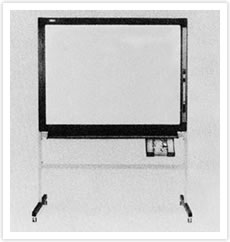Part 16: A New Idea from the OA Business Division: The Kawaraban Electronic Whiteboard
As mentioned in Part II of the management reform plan announced in 1982, OKI declared its intentions to make a full-scale entry into the office automation market. The office automation business initially presented various challenges. However, the introduction in December 1983 of the Kawaraban electronic whiteboard, capable of printing text and diagrams written on the whiteboard, generated instant success. The product would go on to help expand sales channels for OKI's OA business.
Venturing into office automation
In the 1970s, as computers continued to progress rapidly, the concept of OA (office automation) emerged, projecting a vision of a paperless age in which all office functions would be handled electronically. Actually, the term "office automation" made its first appearance in the 1980s, as the arrival and growing use of office computers shifted some of administrative processes to computers by way of data entry. Other related topics included the emerging business use of word processors and printers.
Amid these developments, Part II of the management reform plan announced in 1982 established the business domain of office automation within OKI. Based on the OA Business Division's mission for that fiscal year, which called for achieving profitability in this line of business, OKI established the telecommunications terminal, facsimile machines, and OA equipment (personal computers, word processors, and office computers) business units. At the time the OA business unit, which contained the personal computer, word processor, and office computer businesses, played a central role in OKI's OA business. However, the unit found it difficult to achieve profitability, in large part due to the PC-9801; introduced by NEC in 1982, this product instantly became the de facto standard for personal computers in Japan.
The Kawaraban electronic whiteboard, a product born from the honest opinions of employees

The Kawaraban electronic whiteboard,
a brand-new product idea
Employees in the OA Business Division were eager to move to a new phase for the division, which had weathered rocky beginnings. The Kawaraban electronic whiteboard was one of the products that followed. Its beginnings dated back to October 1982, with efforts to gather ideas for new products within the OA Business Division, under a project called "The Jump-Up Plan". Said one employee: "There has to be an alternative to using tracing paper in meetings and other situations and copying this information right after the meeting as meeting minutes." That suggestion led to the idea of adding a copying feature to a whiteboard.
Prototyping began in the following month. Initially, it appeared development would be simple, since OKI could draw on the scanning and printing technologies that gave it such an advantage in the development of fax machines. But difficulties emerged. The first was the task of horizontally running five surfaces of movable sheets on which office workers could write and erase, just like on a whiteboard, without wrinkles or warping. Running these vertically was easy, but running the 0.95-by-8.5-meter sheets horizontally proved harder. Another issue was that the slightest shaking would affect the optical axis, making it impossible to read the writing. In the end, starting with a clean slate, the team devised a frame resistant to shaking.
Over a development period of one year, with virtually no days off, a prototype was completed. However, 10 days prior to product announcement, an accident occurred. The sheet failed to run well. All personnel involved worked around the clock to resolve the problem, identifying the cause just four days before the announcement. They solved the problem and delivered the new Kawaraban to the announcement venue. OKI embarked on this new business with a mixture of relief and anxiety.
The impact of the Kawaraban on Japanese businesses
The unique idea of the Kawaraban (priced at 750,000 yen), introduced by OKI ahead of any of its competitors, was accepted warmly following its announcement in December 1983. Sales advanced smoothly. The device proved capable of printing the precise content of four of the five movable sheets to A4-sized paper. It could make up to 99 copies at a time. The Kawaraban was a piece of office automation equipment with deep roots in Japan's corporate culture, and it began earning a strong reputation for use in company meetings. Japanese firms, which value consensus among employees, hold frequent meetings. Naturally, it is important to share information in these meetings. The whiteboard is essential to this process.
Until the Kawaraban's debut, listeners had to copy to notes or memos the information the speaker wrote on the whiteboard. In some cases, this resulted in participants not having the time to think or missing an opportunity to speak. The Kawaraban instantly addressed these problems. Its use spread to a broad range of fields, including providing work instructions at the workplace, classes in culture centers, and other classroom settings.
While shipments of the product were strong at first, price competition intensified as a succession of competitors entered the market, eventually forcing OKI to fight by introducing a low-priced Kawaraban Taro (490,000 yen) and Kawaraban Jiro (398,000 yen).
Still, sales of this Kawaraban series helped establish numerous sales channels for OKI, including stationery companies. They would remain assets in OKI's subsequent office automation business.